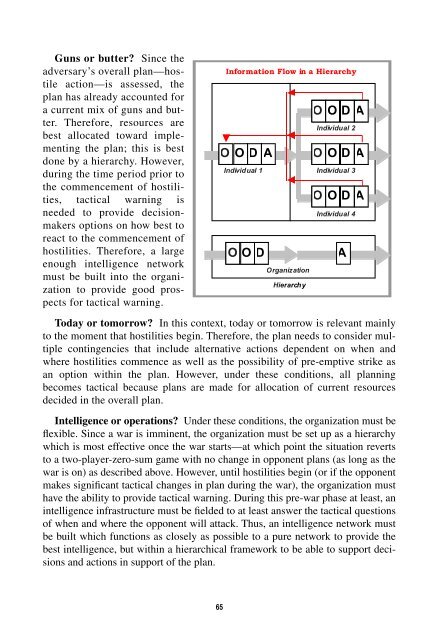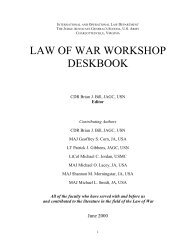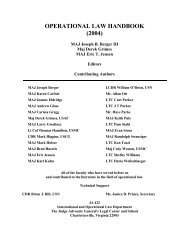Warning Analysis for the Information Age - Higgins Counterterrorism ...
Warning Analysis for the Information Age - Higgins Counterterrorism ...
Warning Analysis for the Information Age - Higgins Counterterrorism ...
You also want an ePaper? Increase the reach of your titles
YUMPU automatically turns print PDFs into web optimized ePapers that Google loves.
Guns or butter? Since <strong>the</strong>adversary’s overall plan—hostileaction—is assessed, <strong>the</strong>plan has already accounted <strong>for</strong>a current mix of guns and butter.There<strong>for</strong>e, resources arebest allocated toward implementing<strong>the</strong> plan; this is bestdone by a hierarchy. However,during <strong>the</strong> time period prior to<strong>the</strong> commencement of hostilities,tactical warning isneeded to provide decisionmakersoptions on how best toreact to <strong>the</strong> commencement ofhostilities. There<strong>for</strong>e, a largeenough intelligence networkmust be built into <strong>the</strong> organizationto provide good prospects<strong>for</strong> tactical warning.In<strong>for</strong>mation Flow in a HierarchyO O D AIndividual 2O O D A O O D AIndividual 1Individual 3OrganizationHierarchyO O D AIndividual 4O O DAToday or tomorrow? In this context, today or tomorrow is relevant mainlyto <strong>the</strong> moment that hostilities begin. There<strong>for</strong>e, <strong>the</strong> plan needs to consider multiplecontingencies that include alternative actions dependent on when andwhere hostilities commence as well as <strong>the</strong> possibility of pre-emptive strike asan option within <strong>the</strong> plan. However, under <strong>the</strong>se conditions, all planningbecomes tactical because plans are made <strong>for</strong> allocation of current resourcesdecided in <strong>the</strong> overall plan.Intelligence or operations? Under <strong>the</strong>se conditions, <strong>the</strong> organization must beflexible. Since a war is imminent, <strong>the</strong> organization must be set up as a hierarchywhich is most effective once <strong>the</strong> war starts—at which point <strong>the</strong> situation revertsto a two-player-zero-sum game with no change in opponent plans (as long as <strong>the</strong>war is on) as described above. However, until hostilities begin (or if <strong>the</strong> opponentmakes significant tactical changes in plan during <strong>the</strong> war), <strong>the</strong> organization musthave <strong>the</strong> ability to provide tactical warning. During this pre-war phase at least, anintelligence infrastructure must be fielded to at least answer <strong>the</strong> tactical questionsof when and where <strong>the</strong> opponent will attack. Thus, an intelligence network mustbe built which functions as closely as possible to a pure network to provide <strong>the</strong>best intelligence, but within a hierarchical framework to be able to support decisionsand actions in support of <strong>the</strong> plan.65
















